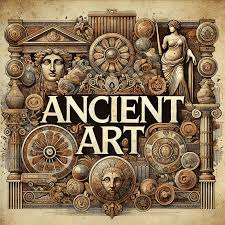Exploring the Rich History of Ancient Artz: From Mesopotamia to Rome
The term “ancient artz” refers to the various art forms produced by the advanced societies of the ancient world, each with its own distinct style, culture, and methods of creating art. From the intricately detailed carvings in Mesopotamia to the grand sculptures of Ancient Rome, the history of ancient artz spans millennia, showcasing the creativity and ingenuity of ancient civilizations. In this article, we’ll take a journey through the rich history of ancient artz, exploring its diverse forms and the unique cultures that shaped it.
The Beginnings of Ancient Artz: Mesopotamia and Early Civilizations
Mesopotamia, often considered the “cradle of civilization,” is one of the earliest places where art began to flourish. Around 3500 BCE, the Sumerians, Akkadians, Babylonians, and Assyrians began creating works of art that not only depicted religious figures and rulers but also told stories of their daily lives and victories. The famous Ishtar Gate, built by King Nebuchadnezzar II of Babylon, is one of the most iconic examples of Mesopotamian art. This monumental structure was adorned with blue-glazed bricks featuring images of lions, dragons, and bulls, all symbols of the gods and royalty.
In addition to monumental architecture, the Mesopotamians excelled at creating cylinder seals. These small, intricately carved stones were rolled across clay to leave an impression of detailed scenes, often depicting myths, ceremonies, and kings. These seals were essential tools for marking documents and conveying authority, making them a significant aspect of ancient artz.
MORE INFORMARTION: https://en.wikipedia.org/wiki/Ancient_Greek_art
The Artistic Innovations of Ancient Egypt
Moving westward to Egypt, ancient artz took on a more formal and symbolic nature. The Egyptians developed a distinctive style that remained consistent for thousands of years. The emphasis on order, symmetry, and idealized human forms became central to Egyptian art. Artists focused on creating works that represented the eternal and unchanging nature of the gods, pharaohs, and the afterlife.
Some of the most famous examples of Egyptian art include the intricate wall paintings found in the tombs of pharaohs, such as those in the Valley of the Kings. These paintings were not just decorative; they were meant to ensure the pharaoh’s successful journey into the afterlife. Statues like the Great Sphinx of Giza and the Bust of Nefertiti have become symbols of ancient Egyptian artistry and are still studied for their attention to form and proportion.
Ancient Greece: The Birth of Classical Art
The art of ancient Greece represents a significant shift toward realism and humanism in the ancient world. The Greeks were fascinated with the human form, and this is reflected in their sculptures, paintings, and architecture. The Greeks developed techniques in pottery and sculpture that emphasized idealized beauty, symmetry, and proportion.
The Parthenon in Athens, a temple dedicated to the goddess Athena, is a prime example of Greek architectural innovation. Its grand design and intricate sculptures, known as the Parthenon Marbles, showcase the Greeks’ ability to blend artistic beauty with mathematical precision. The Greeks also created lifelike sculptures, such as The Discobolus (the Discus Thrower) and Venus de Milo. These masterpieces continue to inspire artists today.
Ancient Rome: The Legacy of Roman Art
The Roman Empire, inheriting much from Greek art, took the classical tradition even further by making art more accessible and practical. Roman art is known for its realism, often depicting historical events, daily life, and important figures in an unidealized way. Roman art was highly effective in serving political purposes, especially in promoting the emperor’s power. The realistic portrayal of figures, such as Emperor Augustus or the Bust of Hadrian, emphasized the ruler’s power and virtue. These portraits were crafted to project strength and leadership. By highlighting key features, Roman art conveyed authority and legitimacy. This approach helped reinforce the emperor’s status. Roman architecture, including the Colosseum and the Roman Forum, also exemplifies the grandeur of the empire. The Romans also mastered the art of mosaics, creating stunning floor and wall designs that depicted scenes from mythology, history, and everyday life.
One notable aspect of Roman art was its embrace of sculpture as a tool for historical storytelling. Reliefs on structures like the Trajan’s Column depict significant military victories, commemorating the accomplishments of Roman emperors. These detailed carvings are valuable historical documents that allow us to understand the visual culture of the time.
The Influence of Ancient Artz on Modern Art
The influence of ancient artz can still be seen in modern art.
FAQs About Ancient Artz
Q1: What is ancient artz?
Ancient artz refers to the diverse forms of art created by ancient civilizations such as Mesopotamia, Egypt, Greece, and Rome. It encompasses a wide range of styles, techniques, and media, including sculptures, paintings, architecture, pottery, and reliefs.
Q2: How did Mesopotamian art differ from Egyptian art?
Mesopotamian art often featured symbolic representations of kings and gods, with a focus on storytelling through artifacts like cylinder seals. In contrast, Egyptian art emphasized idealized human forms and the afterlife, with an emphasis on symmetry and symbolism.
Q3: Why is Greek art considered a turning point in history?
Greek art marked a shift towards realism and humanism. It focused on perfecting the human form and incorporated mathematical principles into sculpture and architecture, influencing art for centuries to come.
Q4: How did the Romans contribute to art?
The Romans excelled in creating realistic portraits and historical reliefs, using art as a tool for political and social expression. Roman architecture, like the aqueducts and the Colosseum, also left a lasting legacy.
Q5: How can I learn more about ancient artz?
You can visit museums that house ancient artifacts. Reading books and research papers on ancient art is another great option. Additionally, you might explore historical sites like the ruins of ancient Rome, Egypt, and Mesopotamia to experience these works firsthand.
Conclusion: A Lasting Legacy
The art produced by ancient civilizations provides a fascinating glimpse into their cultures, beliefs, and innovations. From the carved stone reliefs of Mesopotamia to the grand sculptures of Ancient Rome, ancient artz showcases incredible creativity and skill. These early societies left behind remarkable works. As we study and appreciate them, we see the lasting influence ancient art has had on modern culture, architecture, and art forms. Ancient artz is not just a relic of the past. It is a timeless testament to the power of human expression.














Post Comment